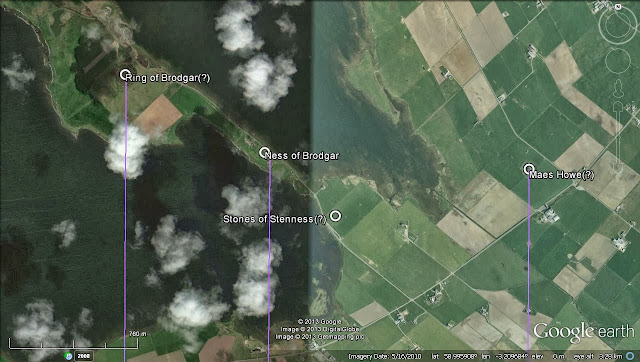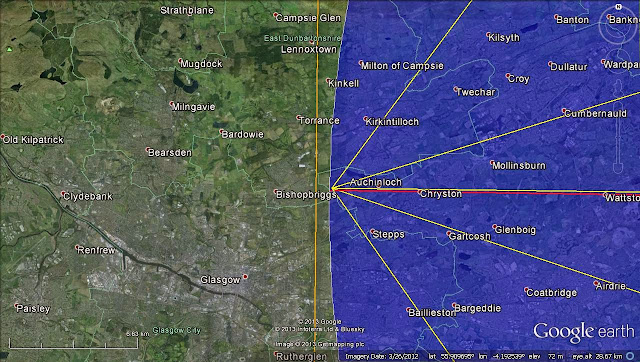The next series of posts details and investigates further the grid I worked on starting some 13/14 years ago, round the turn of the millenium when I had moved to Selkirk from Edinburgh and not only did I become better aquainted with the countryside of the Borders but the geometry kind of 'followed' me! Around that time I was attending a few of the symposia held by the Sauniere Society, which had as honorary president Henry Lincoln, whose geometric findings around Rennes Le Chateau as described in 'The Holy Place' had intrigued me and led to my initial interest in the lanscape of Lothian. At one symposium at Newbattle Abbey, Henry and Erling Haagensen were presenting their work on Bornholm Island in the Baltic, and the associated book, 'The Templar's Secret Island' which I bought there and had it signed by both. I spent many months studying their geometry which was basedon the Danish Kort en Matrikelstyrelsen survey accurate to the milimetre as KenM had used the centre points of the four round churches on the Island as datum points. I had established to my own satisfaction that the basic unit of the hexagonal grid was the modern English mile and that the main axis was (16 times the square of three miles(E)). The square root of three is the altidude of an equilateral triangle of side 2. One half of two is one, so an equilateral triangle can be considered as two right angled triangles with sides (1;sq.rt 3; and 2) with the sq.rt 3 side common.
I had previously found the basis of a grid in the landscape of Lothian and the Borders, centred on St Mary's Chapel, Mount Lothian which is point that was found early in my research, as others had also found and a significant alignment almost due north through Roslin Chapel and the summit of Arthurs Seat and south to a hill top in the Moorfoots, Dundreich. Using maps I had noted that the Bass Rock was at roughly 45 degrees to this line which suggested the diagonal of a square. It was also noted that the line from St Mary's chapel through North Berwick Law was also roughly 45degrees to the said line. I worked away on these two possible grid alignments, completing the square and extending in all directions from St Mary's and incorporating the natural subdivisions of (one and square root of two) squares and circles a quite convincing grid system was found. This extended system also brought the geometry the full distance south to include the area I was now investigating, Selkirk and the Borders.
The move to Selkirk, ostensibly to write up into book form the stuff I had already found, also coincided with my getting an internet connection and contact with William S Buehler and the introduction to his work on grid systems which also included the landscape I was looking at. Indeed, he had the same St Mary's Chapel line but he had it extended to Seafield tower between Kirkcaldy and Kinghorn in Fife, and Dryhope tower near St Mary's Loch at the head of the Yarrow Valley just a few miles west of where I was now staying, but both these points were outwith the scope of my maps at that time. In the next post I will describe the specific format used by WSB, the basic Reshel system which later on in this process I found using a (3by1)diagonal of the grid which was developing.
When I had done enough work on the Bornholm geometry which honed my skills with a calculator I returned to the St.Mary's Chapel/Bass Rock system and to my astonishment the distance from St Mary's Chapel to St Baldricks Chapel on the Bass Rock was the exact, to the metre, same distance as the axis on Bornholm!!!!
This excercise is an attempt to reconstruct this grid in Google Earth, employing a neat application I found where I could draw accuate circles in Google Earth:
 |
| So, first I created the circle using 'radius round a point' a very handy tool, with St Mary's Chapel as centre and radius (168square root of three)miles which coincides with St Baldred's Church on The Bass Rock. Markinch is found to be on this circumference at 45degrees to The Bass, as its often called.I then drew in western half diagonal and the horizontal square side. |
 |
| extension of the axes. |
 |
| completion of the intial square. |
 |
| I then began on the North Berwick Law orientation. Now, NBL is 13/16ths of the full distance, exactly, but is extended the full distance so the circle is common. The vertical and corresponding western half diagonal are also shown. All in red. |
 |
| The blue line is the 'roseline' or Tavhara in WSBuehler's terminology. This line is through Rosslyn Chapel and the summit of Arthurs Seat with Seafield Tower, between Kinghorn and Kirkcaldy where the horizontal from The Bass crosses. |






























